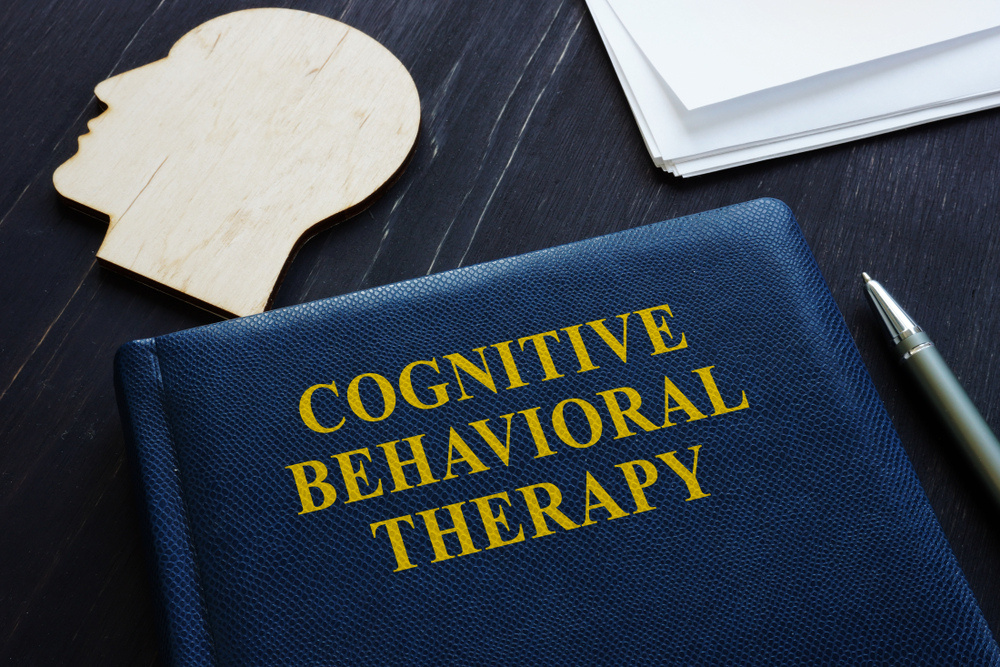Last Updated:
June 5th, 2025

For anyone struggling with addiction, it is common to feel as though half of the battle is in your mind. Experiencing mental health issues is tragically common for people striving to work their way out of addiction’s grasp.
Research shows that 30% to 50% of people with a substance use disorder also have at least one serious mental disorder. This highlights the importance of therapy in supporting the recovery process, with CBT being one of the most powerful kinds.
What is cognitive behavioural therapy?
As a person goes through addiction recovery, it’s usually the case that therapy is used alongside medical detox. Anyone who has struggled with an addiction will know that there are both physical and psychological forces that make quitting a substance extremely tumultuous.
Medical detox is used in recovery to help with the physical withdrawal from a substance, while therapy soon follows to help a person develop the skills and techniques needed to remain sober. Cognitive behavioural therapy (CBT) is one such type of therapy, and it’s incredibly supportive of long-lasting recovery.
CBT was developed in the 1960s by psychiatrist Aaron Beck. In its earlier days, CBT was used to treat depression. It has since evolved into one of the most widely studied and applied therapies for a range of mental health conditions, including substance addictions.
CBT’s overarching aim is to help people identify negative thought patterns and change the behaviours that result from them. It’s a forward-focused therapy rooted in the idea that how we think affects how we feel and act.
Why CBT is so powerful in addiction recovery
The core tenets of CBT make it an immeasurably useful tool for people struggling to break free from the clutches of addiction. CBT focuses on the understanding that our thoughts, emotions and behaviours are all interconnected, as part of a greater chain. It helps a person to see that if they can interrupt one link in the cycle of thinking, feeling and acting, then the entire outcome of the chain reaction can shift.
Some of the most prevalent ways CBT works for addiction recovery include:
- Identifying and interrupting destructive thought patterns: Addictions rarely exist in the mind of a person who always feels happy, content and productive. While almost everyone has experienced periods of glumness, people with a deep addiction are especially prone to bouts of lasting depression or destructive, recurring thought patterns. CBT is designed to help a person recognise these patterns in real time and replace them with more realistic and objective thoughts. Over time, practising to reframe thinking patterns becomes like flexing a muscle, growing stronger with repeated use.
- Managing cravings and emotional triggers: Behavioural psychologists frequently mention the importance of changing “People, places and things” in early recovery. When a person remains sober for a time, then revisiting places where they used to take drugs, or people they used to take them with, can create intense triggers. Even sounds, as subtle as the tinkling of glasses, can be enough to flare up cravings. CBT emphasises techniques to help mitigate the stresses and urges that are so frequent in recovery.
- Building long-term coping strategies: For many people in recovery, remaining sober for the long haul, or even for a lifetime, may feel like an eternal war between temptation and diligence. CBT helps people develop the confidence they need to trust in themselves and that a profound goal can and will be met. In this way, CBT often functions as a life-saving therapy for many.
Some common misconceptions of cognitive behavioural therapy
There is a reason that cognitive behavioural therapy is often cited by experts as the “gold standard” of psychotherapy. It has been proven to treat a wide range of mental health conditions as well as substance use disorders.
However, we recognise that CTB is not a household name that everyone recognises. Some common misconceptions about CBT could potentially hold a person back from using it as treatment.
These may include:
- CBT is focused on “positive thinking”: It is tragic that so many of us associate professional therapy with simply choosing to focus on the bright side of life. CBT does not hold back from recognising the profound importance of our darker periods. It is designed to help you balance your thoughts, as opposed to positive thinking.
- CBT is only for people with severe mental health issues: CBT is effective in treating a wide variety of people, not just those with severe diagnoses. It’s commonly used as a first-line treatment for mild to moderate conditions, including anxiety, depression, OCD and PTSD. Whether someone is dealing with everyday stress or more persistent mental health challenges, CBT offers practical tools that can be adapted to different levels of need.
- CBT is a quick-fix: While CBT may work quickly for some people, it is deeply structured by expert therapists to deliver results over the long term. CBT courses typically last for 12 to 20 weeks, though each person’s course is unique. Some therapists feel that the deepest healing is often found in middle and later sessions.
- CBT ignores the importance of emotions: The basis of CBT recognises how critical a client’s emotions are and how they deeply influence thoughts and behaviours. This is especially important for people working their way out of addictive behaviours. CBT works with you, rather than for you, in helping you recognise where emotions come from and how they can be managed in healthier ways that support sustained recovery.
- CBT is only for adults: While the majority of people receiving CBT are adults, professional psychologists believe that CBT can be adapted for younger children using art, play and metaphors to explain the more difficult concepts.
- CBT ignores the patient-client relationship: Many people who receive therapy, especially for the first time, want to feel a deep connection and establish trust with the treatment provider. CBT emphasises the critical relationship between patient and client and establishes an allegiance of trust and respect.
Is cognitive behavioural therapy right for everyone in recovery?
CBT, for good reason, is one of the most widely used therapies in addiction treatment. It is well structured, real-world focused and practical. However, like any life-changing course, it may not be suited to everyone.
CBT can be seen as particularly effective for people suffering from a substance use disorder and a co-occurring depressive disorder. Research into CBT efficacy demonstrates that over a course of almost 4 years, 43% of people who received CBT had a substantial drop in symptoms of depression.
On the other hand, the NHS states that while cognitive behavioural therapy is effective in treating many mental health problems, it may not be successful or suitable for everyone. Some people may find that trauma-based therapy or Eye Movement Desensitisation and Reprocessing (EMDR) are better suited.
The most important thing for you is to find a therapy type that resonates and supports your long-term sobriety. CBT is an incredibly powerful tool, but it is just one of many paths to recovery and stronger mental health.
I need help with an addiction
Taking the first step to research therapies used in addiction treatment takes courage. If you or someone you love is struggling to fight substance use and addiction, we want you to know that you are not alone.
At UKAT, we integrate Cognitive Behavioural Therapy into many of our addiction treatment programmes. You might be starting your recovery journey or looking to strengthen your relapse prevention tools. CBT in rehab can provide structure and long-term strategies for change.
Our experienced therapists tailor CBT programmes to your personal needs, helping you identify thought patterns and build healthier coping mechanisms. We also combine CBT with group therapy, holistic treatments and medical support to ensure every aspect of recovery is addressed.
You deserve a future free from addiction, and CBT as part of your recovery could be the tool that helps you get there. Contact UKAT today to learn more about your options and take the next step toward lasting recovery.
(Click here to see works cited)
- Dual Diagnosis Model of Care, www.hse.ie/eng/about/who/cspd/ncps/mental-health/dual-diagnosis-ncp/dual-diagnosis-model-of-care.pdf
- Chand SP, Kuckel DP, Huecker MR. Cognitive Behavior Therapy. [Updated 2023 May 23]. In: StatPearls [Internet]. Treasure Island (FL): StatPearls Publishing; 2025 Jan-. Available from: https://www.ncbi.nlm.nih.gov/books/NBK470241/
- “Why Change People, Places, and Things in Early Recovery?” Psychology Today, Sussex Publishers, www.psychologytoday.com/us/blog/understanding-addiction/202106/why-change-people-places-and-things-in-early-recovery
- David D, Cristea I, Hofmann SG. Why Cognitive Behavioral Therapy Is the Current Gold Standard of Psychotherapy. Front Psychiatry. 2018 Jan 29;9:4. doi: 10.3389/fpsyt.2018.00004. PMID: 29434552; PMCID: PMC5797481.
- Elaine Houston, B.Sc. “CBT for Children: A Guide for Helping Kids in Therapy.” PositivePsychology.Com, 7 May 2025, positivepsychology.com/cbt-for-children/.
- “Study Finds CBT Offers Long-Term Benefits for People with Depression.” Department of Psychiatry, 7 Jan. 2016, www.psych.ox.ac.uk/news/study-finds-cbt-offers-long-term-benefits-for-people-with-depression.
- NHS Choices, NHS, www.nhs.uk/mental-health/talking-therapies-medicine-treatments/talking-therapies-and-counselling/cognitive-behavioural-therapy-cbt
- “What Is EMDR?” EMDR Institute – EYE MOVEMENT DESENSITIZATION AND REPROCESSING THERAPY, 3 Dec. 2024, www.emdr.com/what-is-emdr/.


